Austin 20hp Tourer 1912
Dependable As Ever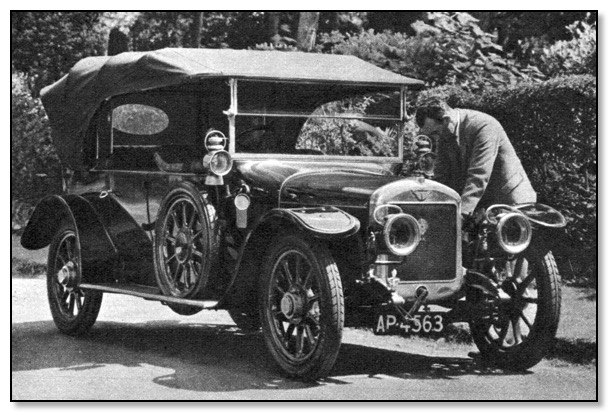
"The steering is irreversible and thoroughly reliable."
Thus read the description of that particular control of the 1912 20 h.p. Austin chassis in the catalogue of the day, and they must have been comforting words to a prospective purchaser.
Recent personal experience of one of these cars shows that the designer had every right to be proud of his layout; and if, after many thousands of miles spent controlling more modern conveyances, the 43-year-old system felt a little direct, it was only by comparison with some present-day designs which feel as if directional stability relies on a system of rubber bands. The idea of taking one of the earlier model Austin on the road germinated some little time ago when several of these cars were seen at the Longbridge works, tucked away in a dark corner; the ambition was realized with the help of John Bowman and Ivor Greening, of the Austin Motor Company.
The latter, in addition to his normal duties, has taken on the task of renovating as many of the Company's early products as is practicable, and the 20 h.p. tourer is one of them. In 1912, of course, body styles had left the "dog cart" stage, although there is still a faint trace of the car's ancestry in the lines of the front seat back-rest. The occupants sat in the car rather than on it, and weather protection, provided by the large hood and by windscreens front and rear, was very good. The general layout and lines of both chassis and body would be difficult to date, unless by some-one of more than average knowledge of the subject.
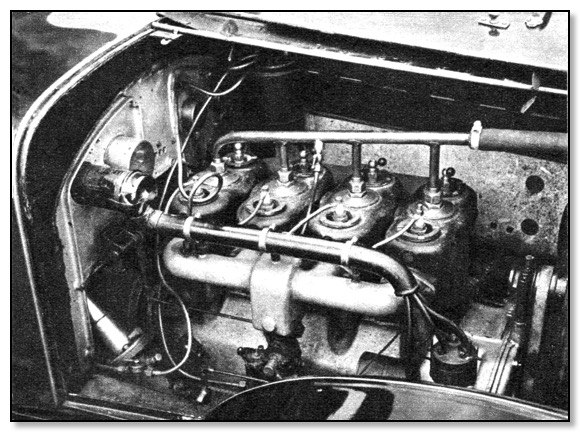
The engine is a four-cylinder side valve unit and it was designed to develop 23 b.h.p. at 1,000 r.p.m., for low speed torque was the target of the early craftsmen. The bore and stroke are 89mm x 127mm, the capacity of each cylinder being 785 c.c. This is worth comparing with the size of the present Austin A.30 engine 58mm bore, 76mm stroke, and the power output of that particular unit-28 b.h.p. at 4,800 r.p.m. Inlet and exhaust valves are operated by separate gear-driven camshafts housed on each side of the crankcase. The top half of the crankcase, which is particularly robust, carries the crankshaft in five bearings. Lubrication of the crank and camshaft bearings is by pump, feeding large quantities of oil at low pressure, for when the engine was turning over the oil pressure gauge needle did not rise above 7 or 81b per sq in. Dual ignition is fitted and a common distributor is used for the magneto and coil systems.
Originally petrol was fed from the rear-mounted tank by air pressure provided by an engine-driven pump on the left side of the crankcase, with an auxiliary hand-pump for starting. On AP.4563 an Autovac has been fitted, and this is possibly the only non-standard feature of this car.
There is no knowledge of the veteran's total mileage since it first left the works; now, after extensive renovations to chassis and coachwork, there is no deceit in describing the car as being virtually new. The paint finish of the body puts many a modern to shame. The brass work of the radiator and lamps sparkles in the sun, and the windscreen fittings have the satin, purposeful sheen of nickel plating. The big seats—and they are big by present-day standards—are covered in soft leather dimpled by buttons in the fashion of the times. Armed with the necessary knowledge, starting this 43-year-old Austin provided no terrors, and Greening, once we were ready to leave the factory, flooded the Claude! Hobson carburettor and turned the engine over a few times with the starting handle to suck in the mixture. The hand throttle was set, the ignition switched on to coil, and by rotating the advance and retard lever round its ratchet above the steering column a spark was produced and the engine fired. This method did not always result in a first-time start as the piston had to be set on the correct stroke. But it invariably worked after one or two turns of the starting handle and was far less exhausting than trying to swing the engine.
Onlookers watching this procedure were suitably impressed and it was thought—this is open to correction—that this method of starting was effective on only one other make of British car, and that equally famous. The engine with its big separate cylinders ticked over slowly with little vibration, and one could well believe the stories told by the old-time craftsmen who, after they had assembled an engine of this type, were not satisfied if they could not balance a penny edgewise on the radiator cap while the engine was running. There is a cone clutch, and it is very definitely " in " or " out " with little movement of the pedal. An interesting feature of the clutch is that the lining is made in six separate sections riveted to a metal plate; these are located on the inside of the flywheel by bolts screwed in the rim. The lining sections can, therefore, be removed for cleaning or replacement without dismantling the whole clutch.
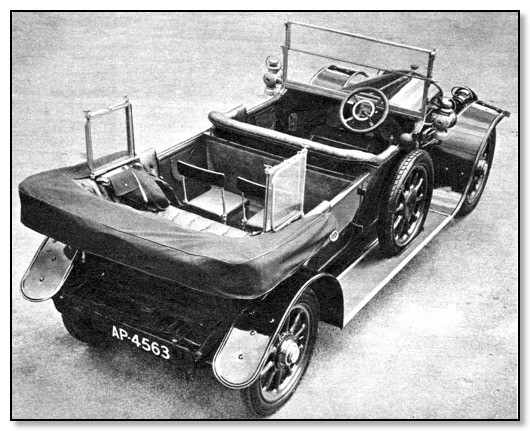
The car was taken from Longbridge and headed towards the Lickey Hills. On first acquaintance it was found easier to change down than to change up. This is what synchromesh does to a driver who was taught to double de-clutch in his early years. However, Greening's advice to pull the lever straight through the gate without a pause helped to achieve a reason-ably quiet change and progress was made without getting too hot under the collar. Up Rose Hill in third for the lower reaches, then second, and finally down to first gear for the final two hundred yards. The car passed Holy Trinity Church, where the founder of the great firm lies which bears his name, and we felt that he would have liked to have seen this day and what care had been taken of one of his early models. Passed the church and then past the grounds of Lickey Grange, where the first 7 h.p. car was designed, to stop briefly for the photographer to do his part: Previously ensconced on the back seat, he had a majestic view of the passing scene and commented favourably on the comfort and extraordinary amount of space.
The big Auster windscreen with its folding frame had been designed to give the occupants of the back seat the maximum of protection, and although with the hood up and screen erected there was a shut-in feeling, at least one was protected from the elements. Down the hill the grand old car went, and in spite of the unfamiliar very high-geared steering which had little, if any, lost movement, control was accurate. The transmission footbrake seemed to have very little retarding power, but the push-forward lever, which operates shoes in the rear wheel drums, gave great power and was fully up to its job. The suspension gave an impression of great comfort,
The carburettor is dwarfed by the very big cast alloy induction pipe. The fan belt is tensioned by coil springs which fit below the fan mounting bracket, and further cooling is aided by the water pump on the far side of the engine. The pulley for driving the dynamo can be seen behind the throttle pedal lever at the back of the engine although it is as well to bear in mind that modern road surfaces help a great deal. There are long half-elliptic springs at the front and full elliptics for the rear axle, which is located by an immense torque arm, stretching from the axle casing to just behind the separate gear box.
Bowling along a sunlit country road with the hood down and the high top gear engaged made one feel that this was the right method of leisure motoring. There was little draught behind the vertical windscreen and it was possible to see much more of the surrounding countryside than one can in a modern saloon.
In its day the 20 h.p. Austin tourer cost £507 10s and the prospective purchaser had an impressive list of alternative equipment to choose from. He had a choice of three different wheelbases and a dynamo belt-driven from the back of the engine was an optional fitting. There was a sprag, for those who lived in hilly counties, at a cost of £1 10s. Amongst the tools and accessories which went with the car was a valve lifter—this was before there were service stations in every big town, and the owner had to be prepared to do most of his own repairs.
12 February 1924
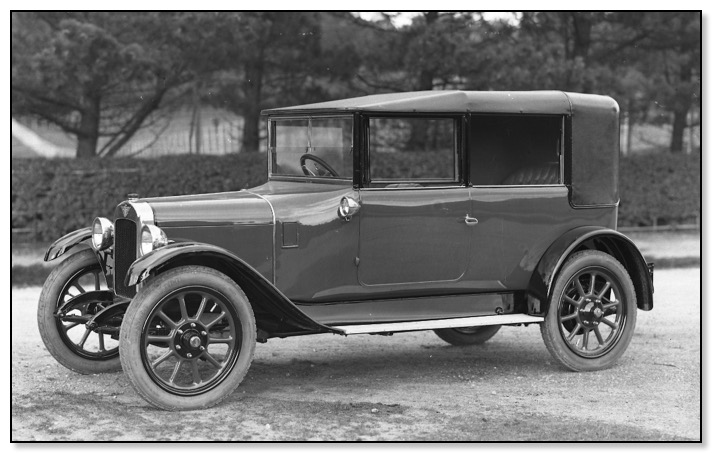
The 12-HP Austin Harley
The four-seated all-weather 12-h.p. Austin is called the "Harley" model. This name was presumably connected with the village of Harley on the Wentworth Estate were Sir Herbert spent his childhood.
The body holds four in comfort, and can be run either enclosed or open. The change over merely necessitates the dropping of the two rearmost window glasses the loosening of a couple of screws, and the pushing back of the head. The central pillars fold down automatically over the recesses containing the window glasses. In this there are disadvantages, and the framework does not easily lie flat, but the one movement of putting back the head is extremely simple.
There as a wide door on either side of the front armchair seats. All four windows are raised or lowered by turning handles, one to each, and the door handles can be reached by driver or front passenger without needless stretching or fumbling. The back seat is entered through the near-side doorway and by sliding the adjacent front seats forward. Both seats in front are adjustable, and the driver's can be tipped sideways to facilitate access to the petrol tank filler and gauge, which are under the seat when it is in position. Each door has a small pocket, and there is a recess to the left of the front passenger's feet; but shelves, drawers, or a cupboard in the scuttle would be better. The front screen is of three pieces, all adjustable, and the two top ones have only one regulating screw each. The jack is kept under the bonnet, and there is a container for the roll holding the small tools on the inner side of the dash. The spare wheel is carried at the rear; there is an interior roof lamp, besides a light on the instrument board, and a folding luggage grid at the back. The body is nicely turned out, and should stand as much hard work as most all-weather bodies. They are not as free from rattles and squeaks after a time as a saloon or fixed head model, but these cannot be turned into open cars.
The Engine
The Austin engine is a four-cylinder of 72 and 102 mm, bore and stroke, or 1,660cc. capacity. It is rated by Treasury at 12.8 h.p., but is said to give 20 on the brake at 2,000 r.p.m. With the clutch and gear box it is held at three points; the front bearing is rubber-lined. Cooling is by a radiator held on rubber blocks to the cross member, sound scheme, by a fan for the belt of which there is a simple adjustment, and by a pump placed forward of the timing on the nearside. A tap in the bottom of the casing and one in the jackets allow the water system to be properly drained. The gland on the pump is adjustable and I should say that there is just enough clearance for repacking without one's having to remove the unit. Aft of the timing on the same side is the magneto, which is driven by chain; it can be tensioned externally. Placing the pump forward makes the magneto readily accessible, in fact, there is good accessibility throughout the chassis. Both cylinder head and block are detachable and side-by-side valves are used. The tappets are enclosed by two covers which can be removed without trouble, though the screws might well be attached to the plates. A breather in each chamber permits a certain amount of automatic lubrication. On the off-side of the engine are the oil-filler well placed and with a deep gauze, a dipper level gauge, the gear driven dynamo, which is held, like the magneto, merely by a strap and so can be quickly dismantled, the easily inspected carburettor, a vacuum tank to draw a supply from the reservoir under the driver’s seat, build,
In spite of the strainer in the oil-filler I should prefer the main filter under the bonnet rather than in the sump, and the bottom plug for running off the oil should be replaced by a tap. For steering gear, worm and worm wheel were chosen, and behind the engine is a single-plate clutch, a four-speed centrally controlled gear box, an open propeller shaft, connected in front by a disc coupling and at the back by a metal universal joint, and a helical bevel driven rear live axle. The clutch has three-finger withdrawal and the housing, which is cast in one with the gear box, has the top open. There is a level tap in the side of the box and the lid contains the gate and change speed mechanism. Lubricant is inserted through a plug hole in the top of the casting. The rear axle casing does not afford easy differential removal. With regard to brakes, a pedal operates shoes in enclosed drums at the rear and a centrally set hand lever applies a locomotive type of transmission brake which is anchored to the gear box. The design is ingenious and simple hand adjusters are provided. Compensation is given by rubber washers. The rear brakes can also be taken up by hand on the primary rod. Chassis suspension is by half-elliptical springs, those at the rear are underslung. Gaiters which, allow leaf lubrication by oil are fitted, and such parts as shackle pins are greased by gun.
On The Road
The roads on the, day of the trial were heavy and slippery, but Amersham Hill was taken on second with a minimum speed of 17 miles an hour, and Dashwood Hill on third, the speedometer never showing less than l2. The gear ratios are 20, 12, 8, and 5.18 to 1, which are perhaps low, though the car can pick up speed rapidly, and between 45 and 50 can be done on the level.
I found the engine quiet, well-balanced at all times, and quick to answer to the throttle. A five-bearing crankshaft and aluminium pistons undoubtedly contribute towards the two last qualities. I should not say that an owner would ever be troubled with overheating, but the weather was too cold during the run to test properly the efficiency of the system. The clutch action was sufficiently light and both the pedal and that of the brake are alterable for length. The pedal shaft is attached at one end to the chassis frame, which, with three point suspension of the engine, clutch and gearbox unit, is not so good, in my opinion, as self-contained attachment; but it is a minor point.
The gears were easily changed, the brakes worked well, being powerful yet smooth in application, and the steering is steady and light. Ample lock enables the car to be turned in a small space.
Of the springing I have no complaint; much of its efficiency is probably due to proper lubrication of the leaves. The various controls are to hand, and in addition to a horn button on the instrument board there is a large circular switch on the steering wheel, so that warning can be given without having to take off a hand.
The 12 h.p. Austin all-weather model looks neat and should render a good account of itself. The price is £525, the tyres measure 765 by 105, and the wheelbase, track, and ground clearance are 9 feet 4 inches, 4 feet 4 inches, and 8.5 inches respectively.
August 1929 Austin Seven
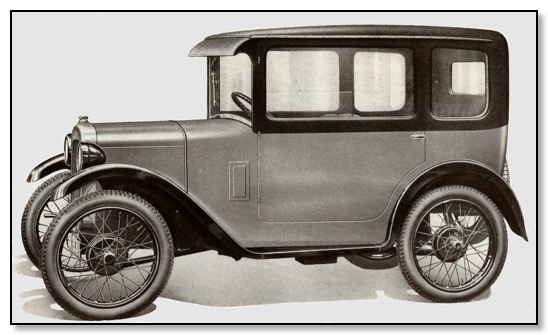
The clever part of the design of the Austin Seven car is the accommodation it provides with a *wheelbase and track of only 6ft. 3in. and 3ft. 4in., while the lay-out of the mechanism is on orthodox car lines.
The 4-cylinder engine is rated at 7.8 h.p., but is said to develop 10.5 on the brake at 2,400 r.p.m. The piston diameter and travel are 56 and 76mm., and the capacity 747.5 c.c. The crankshaft suns in roller bearings, which are lubricated by oil vapour, as are also the aluminium pistons. The big ends are served by catching oil from the pump-fed jets in pockets on the crankshaft webs.
The cylinder bead is easily raised, and the valves and tappets are on the near-side of the engine. There is a cover in front of the latter which is held by two loose hand screws, and when the plate has been moved very fair access is given for tappet adjustment. The sparking plugs are to hand in the cylinder head. Timing is by gear. A two-branch inlet manifold is bolted to the exhaust manifold, and thus the mixture is heated. The carburettor can be got at, and the petrol supply is from a tank in the scuttle. The filler is under the bonnet, there is a gauze here, and also in the carburettor, and the tank holds four gallons. There is no gauge, but one can see the bottom of the tank. The exhaust pipe is joined to the manifold at the forward end, and the coupling, with its brass nuts, is get-at-able.
The film radiator is in a shell, the water circulates naturally, there is a fan and a belt which can be tensioned without trouble, and there is a handy tap on the oft-side to drain the system. The tap might have a curved spout and a hole in the undershield. On this side also is the cross-driven generator with the vertically-driven make-and-break and distributor at its outer end, which position makes inspection very simple. The coil is in a cool place and close to the dash, and close to it are the fuses and cut-out. The oil filler is not tucked away, it is supplied with a gauze, and there is a dipper gauge rod. There is a tray filter in the base which must be dropped for cleaning, and drainage is by a plug in the bottom. Engine, clutch, and gear-box are together, and held at four points on a tapered frame which has the channel towards the ground. The steering box contains worm and wheel, and the combined spindle and drop arm, can be withdrawn so that new-life mesh positions can be obtained. The steering gear cannot well. be got at from above.
The metal floor-board really forms part of the body, but above it there is a small inspection plate over the clutch and also the level filler on the gear-box. The single plate dry clutch passes the power to a three-speed box, and changes are made by a central lever. On the saloon sent for test, the lever worked in a visible gate, but the latest ones are provided with a ball change which also rightly has a catch for reverse. There is nothing to indicate from above the level of the lubricant in the gear-box, but a dip stick could be. used.
The gear ratios are 4.9, 9, 16, and (reverse) 21 to 1. The tyres measure 26 by 3.50in. The propeller-shaft is in two sections. The first part is open and is connected in front by a fabric joint and behind by a metal solution. The propshaft is enclosed in a torque tube and there is a trap in the floor which gives access to the grease valve for the spherical joint and universaL The final helical bevel gear is housed in an ordinary shaped axle case which has a small level plug for oil replenishment by gun. The axle is three-quarter floating. Quarter-elliptical springs are used at the back and a single transverse inverted half-elliptical spring in front. Three shock absorbers are supplied.
A central hand lever works brakes on the front wheels. A common cable is used, but the turns are rather sharp to give compensation in practice. The cable ends are attached to small arms anchored to the bottom of the stub axles and they expand the cams. The front axle is stayed to a cross-member and the stays are of channel section. Adjustment of the cable for the front brakes can be made from above after a metal cover at the back of the gear-box has been removed. Cables are also used for the back brakes and that is a primary hand adjuster reachable from under the running board. All four sets of shoes work in enclosed drums. The fabric covered body gives sufficient head clearance and, although, not unnaturally, it is on the narrow side in front is comfortable enough.
The back seat would take three children or one adult and a child, and there are two wide doors. The drivers seat is adjustable, the near-side seat tips up to give entrance to the back. The windows and the doors are sensibly arranged, as the back half of glass can be slid forward, while the front panel in each door can be wound down. The handles on the sliding panels might be more securely fixed. The after window glasses are fixed. There are two cupboards in the instrument board, and on the top of the steering wheel there are the hand throttle and spark levers and an electric horn button. There is a blind over the rear window and it can be worked from the driver's seat. The battery is under this seat and tools can be kept under the driver's cushion or under the back cushion.
The equipment includes an electric starter, speedometer, scuttle ventilators, and a spare wire wheel had tyre which are kept at the back. The full-length and width of the Austin Seven are 9ft. 3in. and 4ft. 2in., and road clearance just under 9in. The chassis costs £94 10s., and the standard—not de luxe saloon £140, which is the same as the prices of the coach-built saloon and coupe, The saloon tried would do a good 17, 30. and 40 miles an on first, second, and top, while a little more on each gear could be got under favourable conditions. On the stretch nearly 40 was reached, the rates on the new Dashwood Hill were 30 and 15, while with 13 standing start on second the old. hill was cleared at 12 miles an hour. There was a load of about 26 stone, the roads were dry, and the slight wind was favourable.
The car runs very easily, smoothly, and silently on top on the level at 30 or so miles at hour, and this sort of rate can be kept up for long distances. The engine is not noisy, for its size is flexible, and is fairly well balanced. What vibration is felt at times might possibly be damped with rubber insulation. The starter was noisy. Naturally for the best results ant the finest acceleration second speed wants to be used. The speed lever might be a little longer. The clutch was a shade eager, bu allowed the changing-speed to be simple. Both sets of brakes were satisfactory, though the hand one was apt to pull towards the near side. This fault, however, could be cured by adjustment. The suspension was good, and so was the steering, while the machine can be turned in a very narrow space.
The Austin Seven represents one of the cheapest forms of motoring on four wheel while its speed and small over-ail size allow a driver to make an average rate over a give-and take journey equal to many a larger car. The saloon comfortable to drive, and even if an occupant looks somewhat out of proportion he does not feel so.
1930s Austin Sixteen - Folding Head Fabric Saloon
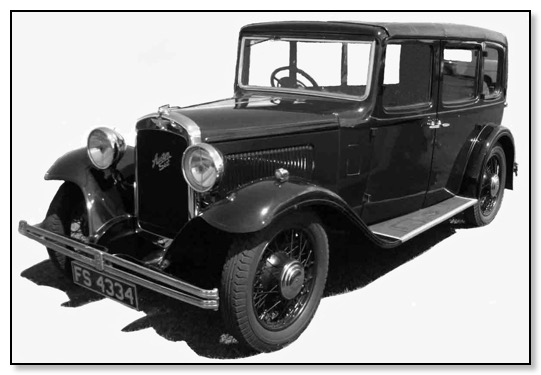
Austin 16/6 Berkeley Saloon, registered 1st January 1933, and had a 'Tickford' hood conversion.
The current owner is Robert Folkes
The Austin Sixteen folding head fabric saloon gives the advantages of both an open and a closed car, where it can be run with full protection along each side, yet with the whole roof folded away.
The engine and the transmission are designed without complication and with accessibility. The six cylinder measure 65.5 and 111 mm., and the capacity is 2,249 cc to be given off on the brake at 2,400 r.p.m. head is easy to lift and has the sparking plugs handy in its centre. the exhaust manifold, which is bolted to the centre of the inlet manifold, has four single ports and one double one in the centre. The pipe is connected to the manifold at the front end, and is swept down below the under-shield. The inlet pipe is circular, with buffer ends, and has two central double branches and a single one towards each end. The vertical carburettor is get-at-able, and has an air filter at the front. Feed is from an autovac tank on the dash, and the main supply of 10 gallons is at the back of the chassis. The filler is large and has a cap which cannot be lost. It is towards the near-side, but there is no gauze here. In front of the tappets there is a divided cover plate held by studs, but with these removed the tappets are sufficiently accessible for regulation and have oil mist lubrication.
The honeycomb radiator is in a shell, and the head stay serves to support the bonnet hinge and as a rain gutter. There is a vertical adjustment for the fan belt. There is a vertical adjustment for the fan belt. Timing is at the back of the engine and is by a chain, without means of adjustment. The generator and water pump are driven in tandem, the pump being the most forward component. It is well to hand with its two hose coupling and large tap for draining the case and the radiator. The gland is free for regulation and for slacking back when repacking has to be done. The cylinder block is separate from the crank-chamber, and there is an outside water manifold for the pump delivery. The generator is held by a strap, and towards its back end there is a vertical drive for the make-and-break and distributor which can easily be examined. the electric leads are rightly short. The coil with the cutout and fuse, are on the dash, where it is cool. The steering box contains a patented roller worm wheel. The pistons are of aluminium, the crankshaft runs in eight bearings, and the engine, clutch, and gearbox are assembled together and held at three points, the forwards bearing being rubber-lined. Tools are in a large cupboard under the bonnet. The single plate half and the pedal can be altered for travel. Both the floorboards are made to be taken out easily. There is an oil cup for the thrust race, and the spigot has a roller bearing packed with grease when erected. The clutch pedal is free of the frame. The neat gearbox contains four forward speeds, which are changed by a central flexible lever having a catch for reverse. There is a top filling plug of proper size and a level tap in the nearside. The starter is built-in on the nearside.
Just behind the box is the customary Austin locomotive brake, applied by central hand lever. The shoes are lined, balanced by rubber washers, and each has a handle for adjustment. The propeller shaft is open, and has a fabric joint in front and a metal coupling behind. The three-quarter floating back axle has helical bevel drive, and adjustment of mesh can be made from outside. Filling arrangements are awkward. The springs front and back are half-elliptical, and have zinc liners to the leaves and silentbloc brushes to the shackles; thus all lubrication is avoid. The back springs are under the axel and outside the frame. The springs are well clipped, but have a little camber. Frictional shock absorbers are fitted.
The four-wheel brakes work directly with rods and cables. There is a large hand primary adjuster easily got at, and the rod joints and the cross-shaft bearings are lined at their sides with felt, which is a simple but good plan. Individual regulation is by moving the threaded rods. The rear brake arms, being behind the axle, are simple to lubricate and the front brakes are free from complication. On either side is an arm anchored to the top of the stub axle; when this is pulled back it depresses a spindle in the hollow pivot pin and so expands the cam. The drums are enclosed, and the steering rods are well out of the way. The spare wire wheel and 30in. by 5in tire are kept in front of a folding grid behind. Wheelbase 9ft. 4in., track 4ft. 8in., and ground clearance 8.5in., the chassis weighs 17.5cwt.
The body is comfortable and has satisfactory head and leg room, it will take five persons Entrance, front and back is very fair and the forward seats are separately adjustable. There are six side windows of good size, the rear light os large as is also the one-piece front screen.
The instruments, which include a petrol gauge, are all arranged immediately in front of the driver, and the other half of that part of the scuttle is used for a big cupboard. there is also a pocket on each door. Below the steering wheel is a rim horn push, and above the wheel in the centre are spark, throttle, and light controls. In the centre, just above the screen, a winding handle works by gear an enclosed cross-shaft with sprockets at the ends. Over these a continuous bicycle chain runs either side. These chains run quietly through channels and are equalized in pull, so that the handle is turned, the roof is moved back from just above the front screen and folded automatically behind and on a level with the top of rear squab, where it lies flat. No windows need to be lowered first, and these can all be in position if desired, with the roof down. The operation of lowering or raising the roof completely from the driver’s seat and working the handle with the left hand takes under three-quarters of a minute. The end of the hadle should not be fixed but free to rotate in the hand. With this sort of roof it is much better to let water in and to drain it away than to try to keep it out; which has been recognized here. I see no reason why the roof should not prove satisfactory so long as the rubber strips on the top are sound. It rained during part of the trial, but not hard.
The winding handle can be locked in almost any position. There are ventilators in the in the side of the scuttle, and two interior electric lights at the back, which are independent of roof movement. The saloon was quite new, but would do just under 30 and a good 40 miles an hour on second and third, while 60-65 is its top speed. With a considerable side wind partly against the car, two persons on board, and damp road. A speed of 50 was reached on the up-gradient stretch, the 30 at the foot of the new Dashwood Hill was increased to 43 at the top, and with a standing start on third 30 miles an hour was shown at the crest of the old hill.
The saloon is handy to drive. The safety glass was rather wavy in effect. The engine gave a good account of itself, being steady, flexible, quiet and cool. the lower gears were commendably quiet, which has not always been the case with Austin cars. Starting from rest in first, the clutch was rather eager, but this ration is really an emergency gear, otherwise the action of the clutch and also the change-speed was quite normal. The hand brake was probably not sufficiently bedded down and so was not much use, but the four-wheel brakes were excellent. The actual suspension can be classed as good, though too much fore and aft motion and some wheel bounce are noticeable. These faults would probably be largely removed by hydraulic shock absorbers. The steering was light yet firm, and there is a wide lock. The forward gear ratios are 5.12, 8, 12, and 20 to 1. The chassis costs £240. and the folding head fabric saloon complete £400.
10 November 1931
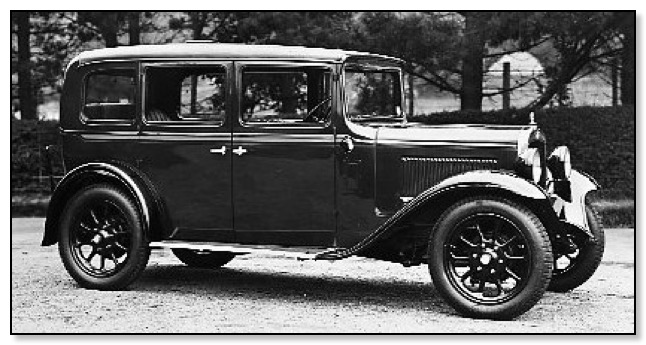
Austin Sixteen-Six Windsor
The Windsor saloon is a sound model and well suited for the present time, as it is a tried product, straightforward in design, and has that steady character which implies reliability.
The pressed steel body is a five-seater with four doors and six side windows. The front seats are movable and have folding foot rests in the backs. The rear seat gives enough support. There are no arm-rest, but an ash-tray is provided each side. The back window and the two rearmost side ones have fixed glasses and blinds. The windows in the doors can would practically right down, and the winders give quick-action and are to hand. A ventilator is fitted in the roof and a light over the back window. A bag type of pocket is on each door, and a cupboard is formed in the whole nearside of the dash, the instruments being grouped opposite the driver. There are pockets in the sides of the scuttle and also ventilators. The can be opened only for ventilation. Safety glass is used all round, and the screen wiper works electrically. The floorboards were rather flimsy on the car tried, but are rightly held by catches and not screws. At the back there are a stop light, grid and a spare wire wheel and 5-20in. tire, while the 10-gallon petrol tank is under the back of the body. The filler is brought to the nearside. It has no gauze, but the cap cannot be dropped. The doors are taken down to the running boards, which improves appearance and, although the seating is not luxurious, it is comfortable, while there is fair head room and quite good entrance by the four doorways. The wheelbase and track are 9ft. 4in. and 4ft. 8in., and ground clearance is 7.5in. or 8.5in. for export.
The cylinder block, which carries the side valves, is separate from the crank-chamber and the engine, clutch, and gearbox unit, are held at three points with rubber in front. The Treasury rating is 15.9. but 36 horse power is stated to be developed on the brake at the moderated speed of 2,400 r.p.m. The six cylinders are of 65.5 and 111mm. bore and stroke, and thus the total displacement is 2,249 c.c. The crankshaft runs in eight bearings, and the pistons are of aluminium. The sparking plugs are handy in the centre of the easily detachable head. The circular sectioned inlet manifold, with its single branch towards each end and two double branches towards the centre and with buffer ends, is bolted to the exhaust manifold above. The exhaust pipe is forward, and the manifold has four single and one central double branch. The carburettor is accessible for adjustment, and the whole of the inside, together with the air cleaner, can be dropped by loosening one hand screw. Feed is from an autovac on the dash. The divided tappet cover plate is evidently not meant to be often tampered with, as it is held by 10 studs.
There is a float oil level indicator, the large and handy filler has a pull-off lid and a big gauze inside, and at the back of the engine there is a circular oil filter. Drainage must be effected by undoing a plug in the bottom of the base. The oil is forced to the main and camshaft bearings. The radiator stay is held to the bonnet hinge and acts as a drip gutter, but while the bonnet can be adjusted, the stay cannot. The honeycomb radiator, however, however, is in a shell. Vertical adjustment is provided for the fan belt,. On the off-side there, is an easily reached tap at the lowest point of the water system and below the pump casing. Timing is at the back of the engine, and from there the generator and water pump are driven in tandem. A vertical drive is obtained from the back of the generator for the make-and-break and distributor, which are easily adjustable for timing. The coil is on the das, or rather on a metal cupboard which contains tools and to which the electrical cut-out and fuse are held, while the lid of the cupboard on either side acts as a bonnet support. The generator has a push-in coupling and strap fastener. The pump connexion has studs. The gland is get-at-able for adjustments, and there is clearance for repacking. The three rubber hose connexions are not out of the way. The worm and worm wheel steering is held by a bracket to the frame. The single plate dry clutch has a roller bearing which is packed with grease when erected, and there is an oiler, brought up to the floorboard in which there is a hole, for the thrust-race. The travel of the pedal can be altered with a spanner. The housing is open at the top, which makes inspection simple. The gearbox is of the orthodox type with four forward speeds and a central flexible lever which must be lifted to engage reverse. There is a top filler plug and a level tap, which is convenient. The starter is built-in on the near side and the end of the spindle is squared.
The open propeller-shaft has a double flexible disk joint in front and a metal universal behind. The helical bevel back axle is three-quarter floating and has a built-tip case. The mesh can be adjusted from outside. The filling arrangements could be bettered. Both the hand lever and brake pedal apply the four-wheel brakes without servo or compensation. There is no fifth brake. The hand lever is on the off-side of the speed lever and of proper solid construction. The system employed for operation is ingeniously simple. A bolt passes longitudinally through the lever near the bottom, and this effects adjustment The rear end of the bolt presses against a rubber-buffered piece, which in turn rotates the brake cross-shaft and thus applies all four brakes. The shaft has oil-soaked felt washers which gave attention and take up side pull. The whole arrangement is very straightforward and accessible. Part rods and part cables are used for the brakes, and there is a large hand primary adjuster on the pedal rod. Individual regulation must be done on the rods. The front brake working arms are anchored to the top of the stub axles, and the enclosed drums have drain outlets.
The springs, are half-elliptical front and back, have zinc-lined leaves and silentbloc shackle bushes. They are practically flat in front, held out of centre, and well clipped. There are no stops at the back. The rear spring are under the axle. Frictional absorbers are fitted. The four forward overall ratios are 5.12., 8. 12, and 20 to 1, and the turning circle is 42ft. The weight of the saloon is 25.3cwt., and the price £298.
The car submitted for test was not in its best form and had done only about 800 miles. I reached only 60, and then under somewhat favourable conditions, though the car in good shape should be able to do this on the level without undue pushing. About 30 and 40 are the greatest rates on second and third. On the stretch 51 miles an hour was shown and the speedometer was certainly not fast: 30 and 43 were the rates on the new Dashwood Hill, and with a standing start on third the crest of the rough old hill was passed at 30. The slight wind was across, the roads were dry and the load consisted of two persons. The engine, except for some slight vibration at low speed under heavy and sudden load, was smooth and ready enough, said the car ran up to 40 and 45 miles an hour easily and without needing to be pressed. The cooling was amply efficient. The clutch was, if anything, rather an the firm side. The change-speed is convenient and quiet changes can be made. The lower gears were moderately quiet. The suspension was fair and would probably, be improved with better damping. The steering was steady and light with a good-sized and well set up wheel and with a horn ring below. The brakes were excellent by hand as well as by foot, being strong, even, and progressive, yet not requiring undue force.
Austin Light Twelve - Four (1932)
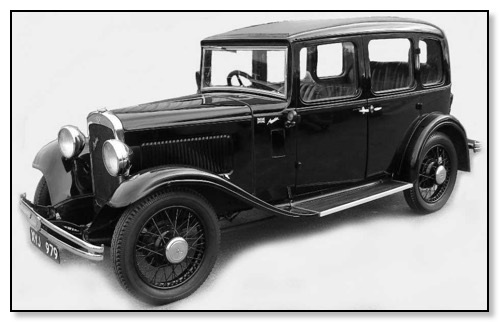
The Austin Light Twelve-Four saloon, de-luxe is not fast and the vigour of the engine can be felt at slow speeds under toad, but it cruises enjoyably at 35 to 40 miles an hour for mile after mile. This quality, with the engine's sturdiness in climbing, makes it attractive.
The body is built to take four persons comfortably. The front adjustable bucket seats have folding footrests in their backs; behind are three armrests. The rear seat is rather high; but the six side windows are of good size. The four doors give fair entrance; there is a sliding roof. The equipment includes an electric wiper, a very big cupboard in the dash, bag pockets on the doors, ventilators in he sides of the scuttle, bumpers, a large-hub sare wire wheel and tyre behind a luggage grid, and the usual instruments and a clock. The upholstery is of hide. The screen, which gives the driver a good view, can be opened only for ventilation.
The cylinder head is easily lifted and the sparking plugs are handy in the top of it. The two-branch downdraught inlet is cast in one with a four-branch exhaust manifold; the whole is held by five nuts. The exhaust pipe is forward. The carburettor is high and bolted to the inlet; the tappets of the side valves are free of access, after a cover, held by two hand screws, has been dropped. A glass bowl filter and petrol pump are also to hand. Oil drainage must be done from underneath. Timing is by a short chain.
The 4-cylinder engine, single-plate dry clutch, and four-speed centrally controlled quiet-third gearbox form a unit held on a level with the flywheel by a bridge cross member at a point on either side with rubber insulation; in front an upswept tubular cross-member, riveted either side to the frame, carries in a rubber bush a bracket which in turn supports the engine. The upper part of the bracket holds the combined fan and generator; by swivelling these parts the tension of the vet belt can be altered. The bracket holds the front of the engine by four bolts. The honeycomb radiator, through which the water circulates naturally, is in a shell. Owing to the narrow chromium-plated casing, the filter is rather small. On the off-side of the bonnet there is a get-at-able water tap, and the oil filler and dip-rod. The filler has no strainer, and the filter is in. the base.
The make-and-break- and distributor can be quickly seen. The coil is upside down-which is better for wet - on the dash, where the tool-box is also. Steering is by worm and wheel, with the box held to the frame. The single-plate clutch is accessible, as the floorboards come out and the housing is open at the top. An oiler for the thrust race can be got at through a hole in the boards. The starter, built in on the near-side, has a squared end. The speed lever works in an invisible gate, and has a catch for reverse; the box has a top filler, get-at-able without moving the floorboards, and a level plug below.
The open metal universally jointed propeller shaft leads to a three-quarter-floating spiral bevel back axle. The case is built-up, but the mesh can be altered from outside and there are breather pipes. Just the four brakes are fitted; and these are worked, by pedal or simple central hand lever application, by rods and cables. There is a primary hand adjuster, the individual threaded rods can be taken up, oil-soaked felt washers are used with the-joints, and the cross-shaft is stout, short. and attached to the front of the channel cross member.
On The Road
Driving is simple, though the front pillars could be thinner. The saloon would do about 20, 35, and 50 miles an hour on the level on second, third, and top. 'The engine ran, quietly, and third was free of hum. The clutch was rather responsive when starting away on first, but it took up the load satisfactorily at other times. The gear change was normal, but the top of the lever might be cranked a little towards the driver. I liked the steering; the brakes, but for a slight pull towards the off-side in front, behaved well, as did the rear ones by hand, both ways. The progressiveness of the action is safe and pleasing. The suspension was quite good, and there was the least wheel bounce. The driver cannot easily get to his seat from the nearside.
With the wind across and slightly favourable 49 was reached on the stretch, 30 and 37were the rate on the new hill, with the wind against the car in the cutting, and with a standing start on third the top of the old Dashwood Hill was passed at 25 miles an hour. With little hope that the car would get away, I tried a standing start on top. With a slight slip, the clutch and the engine took up the load well and carried the saloon to within 240 yards of the crest.
There was the usual load and the roads were dry. This model costs £198, the ordinary saloon being £178.
Specification.
Number of cylinders. 4: size, 69.3 by 101.6 mrn.; Capacity, 1.535cc.; Nominal hp. 11.9; bhp.. 24 at 2,400 rpm. -. Number of main bearings. 3. Overall forward gear ratios, 5.5, 8.6. 13.4. and 20.8 to one. Petrol capacity. 8 gals, ; tyres. 4.75-19 , Turning circle, 42ft. ; Wheelbase, 8ft. l0in., Track. 4ft. 2in, Ground clearance. 71/2”. Weight of car, 19.2 cwt.
Austin Seven (1932)
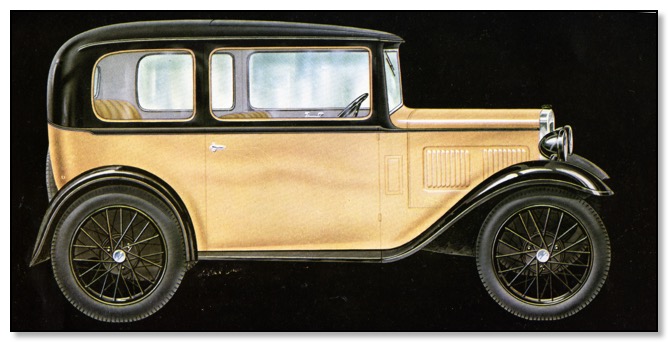
The Austin Seven, with its four-speed gearbox and excellent suspension, should sustain its popularity. The body gives good comfort for four persons. The cushions are pneumatic, the front seats are bucket-shaped and Adjustable with bolts, the seats lip forward, the wheel arches make arm-rests at the back, and the squab here is shaped. There are deep and sloping wells for tile feet of the back passengers. The two wide doors have long pull strips and convenient window winders, the quarter-lights are big. The screen will open only for for ventilation; the wiper works by suction. There is safety glass throughout, and there are no floor boards to take out. All points which require periodical lubrication can got at by merely lifting a rubber cover or metal trap. The spare wire wheel is at the back, where is also the petrol tank.
The head of the four cylinders is easily lifted and the sparking plugs are fully accessible in it. The two-branch circular inlet is above and cast in one with the exhaust manifold and thus has a down feed from a carburettor which is high, and easily got at. The exhaust pipe is forward. The tappets of the side valve can be adjusted fairly easily. The mechanical petrol pump is not obstructed. Drainage of the sump is by a plug underneath but towards the nearside. The pistons are of aluminium alloy, the larger and stronger crankshaft has roller bearings, and timing is by gear. There is a fan with eccentric adjustment of the belt, and the water circulates naturally to a honeycomb radiator in a shell.
On the offside the cross-driven generator is held in the fan mounting. At the outer end of the generator are the make-and-break and distributor, which are driven nearly vertically. Good points here are the short leads, and the ease by which the electrical parts can be inspected. The starter is built-in front of the flywheel and is simple to withdraw. The worm and wheel steering box is behind on the frame, but end play can be adjusted at the bottom of the column inside the car.
Engine, single-plate clutch, and twin-top gearbox form a unit, which is held on the triangular inverted-channel frame, which has been the foundation of the success of the Austin Seven. The oil lead for the clutch bearing can be reached without disturbance, as can also the level filler for the gearbox and the bearings of the divided propeller-shaft. The gearbox has constant-mesh for third as well as top, and the central flexible lever has a catch for reverse.
'I'he front part of the propeller-shaft is open and has a fabric-jointed front and a metal universal coupling behind; the after section of the shift runs in a torque tube. A longitudinal drilled member connects the two middle cross-members. For the three-quarter floating spiral bevel-driven back axle there is a level plug at the back which is not very accessible. The quarter-elliptical spring here are splayed and shackled at the back below the axle; they fit into the channel of the frame in front, and have frictional shock absorbers with long arms. The front suspension is by a transverse spring fully shackled at either end, and having a double frictional shock-absorber, transversely set in front of the axle. The axle is stayed to a cross-member behind the engine. The four brakes are worked by cables, except the primary pedal rod, and by foot or central hand lever. There is a winged nut underneath for adjustment of the front brakes, which have some compensation by the use of a common cable for the two. There is also a winged nut under the offside running board for primary regulation of the four brakes by pedal.
On The Road
The engine pulls well and is flexible for its size. The car, especially with the right use of third gear, is lively in acceleration, and the balance for a two-bearing unit is satisfactory. Some of the gearing could be quieter but the clutch, which has a short travel to the pedal, worked well and easy and quiet changes can be made. The twin top is a most useful addition. Silent changing into top can be done with a pause midway. The steering proved reliable and easy in the ordinary way, although a little stiff on the lock. The brakes, by hand or foot and in either direction, were powerful enough, but on the car tried called for some pressure. I believe larger brake arms are now fitted, thus providing more leverage. With the suspension there were the least bounce and fore-and-aft movement, and my reading tests were passed very much more easily than on many larger and much more expensive cars. A good 20 and 30 miles in hour are possible on second and third, and while 40 can be done on top against a slight rise, 45 is about the comfortable maximum on a genuine level. Forty miles an hour was reached on the stretch, the rates of 30 and 19 on the new Dashwood Hill were good, and with a standing start on third the crest of the rough old hill was passed easily at 15 m.p.h. This Austin Seven costs £125.
Specification. Number of cylinders. 4: size. 56mm. by 76mm. ; capacity, 745.5c.c. ; nominal h.p., 7.8: b.h.p., 10.5 at 2,400 r.p.m.; no. of main bearings. 2: overall forward gear ratios, 5.25. 9.6. 14.4. and 23.3 to one: petrol capacity. 5 galls. tires: 3.5 - 19: tires. 6-18in. ; turning circle. 33ft. ; wheelbase. 6ft. 9in.. track. 3ft. 4in.: ground clearance, 8.3in. ; weight of car. 10.5 cwt.
Austin Ten-Four (1932)
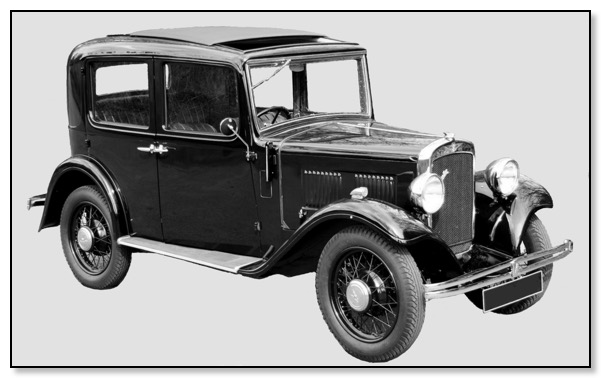
A car which gives proper leg, elbow, and head room for four grown persons, has a good turn of speed, is geared to tackle steep hills and city traffic easily, is simple to handle, and costs no great sum complete, like the Austin Ten-Four, should be in demand. This model comes between the Austin Seven and the Twelve-Six.
The frame is double-dropped and is so devised that, except for the prop-shaft casing, the floor is flat. Thus, without sacrifice of stability or head clearance, entrance and exit are simplified with the absence of wells. There are four doors, which are taken down to the running boards, and the four side windows are in the doors and have handy winders. The after glasses can be let down a good third of the way, and the front ones fully. Safety glass is used throughout. The windows give a good view and are not too low, and the rear window is of a proper size with a pull-up blind, which can be worked by the driver. The large one-piece screen will only open for ventilation; it has an electric wiper. Half the roof can be slid back and fixed anywhere by one frictional hand-screw. There is a roof light and inside reflecting mirror, and ventilator are in the sides of the scuttle. The rear doors on the car tried, should have been made to open further. Each door has a bag pocket, and the near-side half of the dash makes a good cupboard, the instruments, which include a clock and a petrol gauge, being all in front of the driver. On the top of the steering wheel are the dip and switch headlamp control and the horn button. The hand air choke on the dash opens the throttle, The back seat, although a little upright in the squab. gives good room, and the regularly shaped front seats allow a useful space below. The upholstery is of leather, the seats are comfortable, and better entrance by all four doorways is given than on most cars of this size. The tools and battery are conveniently kept in a locker under the bonnet and the spare wire wheel and 4-19in. tire are in front of folding grid. The back of the car is neatly and cleanly finished off; there is a bumper each side to protect the wings. The six-gallon petrol tank has an accessible filler on the near side. There is no gauze in the mouth, but the cap cannot be lost. A stop light is included, and a full bumper in front. There are only nine greasing points on the chassis.
The compact four-cylinder engine has dimensions of 63.5 and 89 mm., which make the capacity 1,125c.c. The nominal power is 10, but 21 is stated to be given off on the brake at 3,400 r.p.m., The pistons are of aluminium alloy, the lubrication follows customary Austin practice, the valves are all on the near side, and both crankshaft and camshaft run in three hearings. On the off-side there are the make-and-break- and distributor, with wholly automatic advance and retard, which are driven at an angle to the vertical and conveniently face the operator. A pointer and a scale are provided for resetting. The coil is near and held to the frame, and on either side of it is a junction box. The cut-out and fuse, with a spare are on the dash, and the fuse also a spare on the dynamo is equally get-at-able. The dynamo is combined with a fan and held to the cylinder head; there are vertical means of adjustment. The oil filler, though well extended, has rather a meagre conical gauze. A dip rod gauges the level in the base. The method of drainage does not encourage a change of oil. The starter is rather under the steering, but it has a squared end, which is easily reached. The cooling water circulates naturally through large-bore pipes. The hose couplings are not tucked away, nor is the water tap, which has the hole towards the ground.
The honeycomb radiator is in a shell. worm and wheel are used for the steering, the drop arm connexion is serrated and therefore allows new positions to be obtained; the box is held to the top channel of the frame. On the near side a single plate in front of the tappets is held by two loose hand-screws. With the plate removed the tappets call be seen, but owing to their height it would be easier to slip off the manifolds before adjustment. I liked the look of the manifolding; the two pipes are cast in one and held by five nuts. The exhaust pipe is forward. Timing is by roller chain without adjustment, though the sprocket centres are short, The oil relief valve can be reached. The carburettor is bolted directly to the down-curved inlet, and with one top screw loosened, the float chamber and jets can be dropped. Below but accessible is the petrol pump. The sparking plugs can be worked by an ordinary spanner in the top of the detachable cylinder head. The single-plate dry clutch has a ball spigot bearing, which is packed in assemble; and an oiler for the thrust race can be got at without having to remove any part. The pedal shaft bearings have no lubrication. Clutch and brake pedals can be adjusted.
The gearbox four forward speeds with a quiet-third and changes are made by the central flexible lever which his a stop for reverse. Engine, clutch, and gearbox are held in three silent-bloc bearings. The propeller-shaft, of good has metal universal joint; no greasing part compels the operator to get under the car. The spiral bevel driven axle is three-quarter floating with a built-up case. There is a level plug and a needlessly small filling one. The suspension has frictional shock absorbers and is half-elliptical. The back springs are flat under the axle, under the frame, are slanted, and like the front have silent-bloc bushes. The front springs have some camber, but are held out of centre and much splayed. The front axle has rounded ends.
The four brakes are worked by pedal or by hand lever on the offside of the speed lever and with ingeniously simple application. There is a master adjustment and no compensation. Cables are used throughout, except for the first section of the back brakes, where rods are employed. The front brake spindles are neatly carried in the axle and felt washers are fitted. Wheelbase, track, and ground clearance are 7ft. 9in., 3ft. 9in., and 7.5in., the turning circle and the weight of the car complete are 37ft. and 15.5cwt., and the four forward overall gear ratios are 5.25, 8, 12.8, and 20.7 to 1. The saloon is neat rather than handsome and one in which utility has not been sacrificed to prettiness. The saloon costs £168.
On The Road
The greatest comfortable speeds are about 25, 40, and 55 on second, third, and top. The delight, of the car lies in the easy speed and in the way it holds the road. Thirty to 35 is an effortless cruising rate with light throttle, while 40 to 45 is quickly attained and without pressing. Over 50 takes distance and persuasion, unless the conditions are favourable. The tests were well withstood. There were two persons in the car and the roads were dry, but the breeze was across and against it. On the stretch 46 was reached, the 30 at the foot of the 1 in 22.5 hill was increased to 37 by the top, and with a standing start on third the crest of the old Dashwood Hill was defeated at a good 23 miles all hour.
On occasion one can feel the engine slightly, but it is generally well balanced and quite, and livelier than some former Austin’s. for its size it is unusually flexible, has good pick-up, and sustains its load, the cooling worked adequately, and I liked the clutch and change speed actions. third is not as quiet as top; here is a slight sing, especially on the overrun, but is not noisu. The speed lever in reverse is rather close to the handbrake lever when on. The brakes were powerful, well graded, and progressive, offering the right amount of resistance. The steering wheel is well placed, and but for a little vibration the action was true and light, and the lock allows the car to be easily turned. the suspension is good, but would probably be better with flat springs in front and hydraulic shock absorbers. These would probably check a little fore-and-aft motion which one feels, on a rough road, in the back. In front, one travels very smoothly, and the car is undoubtedly stable.
28 August 1934
Austin Twenty Seven-Seater Landaulette
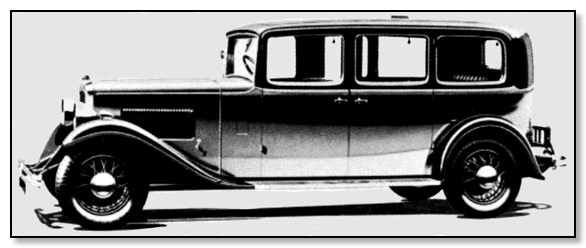
The Austin Twenty seven-seater landaulette is eminently of straightforward design. It has no f rills or super-refinement, but is an honest job car modestly priced, and upholds the aim of trustworthiness which the Austin organization has kept before it for well over a quarter of a century.
The body is built with a rather sharply sloping back seat. Travelling, however, is comfortable and there are three arm-rests here. The occasional seats are not concealed, but when unfolded do not cramp space behind, and they give good room. All six side windows open, and attached in adjustable metal frames to the front pillars of the forward doors are glass wings or shields. These keep the door glasses clean and allow ventilation while travelling. There is a winding glass partition, so that the car can be owner or chauffeur driven. The equipment includes six blinds, a dictaphone, recessed companions which can be got at without having to crook one's elbow, a root ventilator, and two lights at the rear.
The driving seat is comfortable and gives good leg room, and there is satisfactory entrance all round. The wiper arm in front of the forward passenger might be extended to give a better cross view to the driver or the wipers might work from below. The outside reflecting mirror should be placed higher, as in its present position it forms rather a blind spot, and the front pillars are none too thin. There are traffic signallers, with the spare large-hub wire wheel in a metal cover is at the back in front of a grid. There are bumpers, and the petrol filler is brought out to the near side. The back of the car is tidy. This landaulette, though somewhat square looking compared to the flowing line usual to-day, looks what it is a practical car with an honest character.
The engine looks neat and clean. On the off side are the water taps for the jacket radiator and pump, the water-pump with its adjustable gland which. allows repacking, the generator, which is in tandem with the pump, and farther aft the vertically driven make-and-break and distributor. All these parts are fully accessible, as are also the renewable oil filter and the coil on the tool-box on the dash. There is an outside water manifold on the pump side of the cylinder block and also one with two leads above the detachable head. The block is separate from the crankcase. The thermostat for the water circulation is handy. There is cam steering and the box is get-at-able. The honeycomb radiator in a shell is helped by a fan which has eccentric pulley mounting for belt adjustment. On the near side the sparking plugs in the head can be worked by an ordinary spanner, the manifolding is tidy with the four single and double branch exhaust held centrally and above to the six-branch circular inlet manifold, which has square-sectioned branches. The exhaust pipe is forward. The dual carburettor has an air cleaner, and the tappets working the side valves are quite free of access with two cover plates dropped by hand. Near there is a large oil filler and gauze, together with a convenient float level indicator. An autovac tank is on the dash. Drainage of the oil must be done from below, but the nipple for the clutch thrust race can be got at from under the bonnet.
The starter is under the boards, but these are only clipped down. The 6-cylinder engine, the single-plate dry clutch, and four-speed gearbox, which has constant mesh wheels for second as well as third and top, and synchromesh for third and top, form a unit which is held at three points, the forward one being a large strap bearing with rubber. The rest of the transmission consists of an open propeller shaft with metal joints and a three-quarter floating spiral bevel axle. The four brakes are worked by hand or foot by rods and cables, and the front spindle arms are attached to the top of the stub axles. The centrally placed hand lever is on the off side of the gear lever and therefore handy; the gear lever comes rather near the front passenger when second gear is engaged. Long half-elliptical springs with silentbloc shackle bushes, zinc interleaves, and hydraulic shock absorbers are used.
The engine is sound in its running, having enough acceleration, power, and speed for the type of vehicle. The timing is at the back of the engine and can be heard, though some of this hum would disappear with use, the car had done only thirteen hundred odd miles, and an insulated bulkhead and floorboard should help. The engine feels hardy and robust, and although the car cannot called fast it runs, rapidly enough for its average owner. The clutch, like that on other Austins; is rather too sensitive on first and starting is best done on second. It stood the standing start well, and I liked the gear change, the synchro-mesh answering properly. The brakes were good both ways, and the hand ever produced enough force. The steering action was steady yet light, and the gearing was not too high. I was quite satisfied with the suspension on this landaulette. About 25 and a good 40 can be done on second and third, and 55 is fairly easily attained against wind and gradient on top. when sufficiently run in and with enough distance it should be possible for the car to do 65. On the upgraded stretch the rates were 15 and 52, on the 1 in 22.5 Dashwood Hill 30 and 47 miles an hour, and with a standing start on third the top of the old hill was passed at 32. The roads were wet, the load was two, persons, and the strong breeze was on the side and against the car.
Number of cylinders. 6: size, 79.5 by 114.5 mrn.; Capacity, 3,400cc.; Nominal hp. 23.5; b.h.p., 58 at 2,600 r.p.m., Number of main bearings. 8. Overall forward gear ratios, 4.67, 7.34. 11.41. and 20.34. to one. Petrol capacity. 16 gals.; maker's estimate of petrol consumption, 16-18 m.p.g.; tyres. 6in. by 18in.; Turning circle, 50ft. ; Wheelbase, 11ft. 4in., Track. 4ft. 8in, Ground clearance. 9in.. weight of car, 36 cwt. price £595.
Austin Ten Cambridge 1936
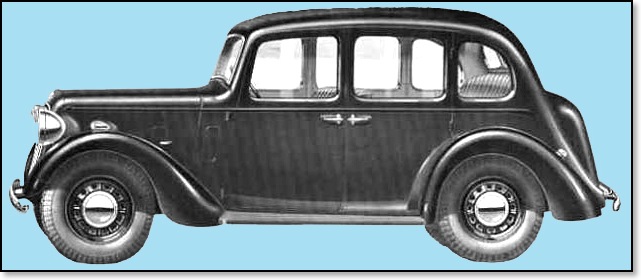
The Austin Ten Cambridge saloon looks more attractive and gives more room than its predecessor, and shows mechanical improvement in a number of ways.
The engine being placed more to the front and the back seat rather forward of the axle, together with greater width of beam, there is greater room and better seating. Head clearance also is not cut down. There are four doors and six side windows; the quarter lights are fixed. The view is not needlessly restricted. The driver has an excellent sight of the road behind and a good one in front, except for the pillars which, for their angle, are rather too thick. The steel body has a sliding roof, toughened glass all round, slip pockets on the doors, a big cupboard in front with the grouped instruments opposite the driver, a winding windscreen, a roof light which has a neat press button switch, two visors, and twin electric wipers each with its own control.
The after floor is flat except for the propeller-shaft tunnel, and the seating all round holds one well in place and gives proper support. Entrance behind is rather restricted unless the adjustable front seats are moved forward, but that in front is easy. Moreover the forward doors open rearwards, which is right for safety. Special care has been taken to insulate the body against noise, and roof, floors. and panels are treated accordingly. At the back, there is a compartment which will take a trunk, and The large door, when let down will take additional luggage.
This well know 4-cylinder engine has, on its nearside and easy to reach, the adjustable thermostat for the natural water circulation, the sparking plugs in the detachable head, a horizontal carburetter, a mechanical petrol pump, and a water tap which drains towards the ground. The valves are at the side and the tappets can be got at for adjustment with the carburetter lifted. On the other side and equally get-at-able are the water filler ventilated dynamo which is combined with the fan, the inverted coil on the dash, the make-and-break and distributor with automatic advance, the oil filler tube, the dip-stick. and the starter. The drive is taken to the four-speed centrally changed gearbox by a flexible type of clutch in which the two friction rings are carried by the centre plate and held apart by leaf springs. The gearbox has synchromesh for second, third, and top. The propeller-shaft is open and the three-quarter floating axle has spiral bevel drive. The half-elliptical springs act with hydraulic shock absorbers, and the four wheel brakes are of the Girling wedge and roller type with automatic compensation between the front and rear sets. Jacking pads are provided, steering is by hour-glass worm and sector.
The saloon runs steadily, with reasonable acceleration powers, and an excellent third-gear ratio. These qualities, together with the handiness of the car and its good braking, make the saloon quick to get along in traffic. The engine has the feel that hard work will not distress it, and that reliability is one of the first of its qualities. Except for a little exhaust noise with the fuller throttle openings, it ran quietly up to its limit and the absence of over-run is commendable. The anchorage of the power unit results in smooth operation at all times. The clutch pedal is rather to the left of the driver's sitting position, but there is safe space between brake and accelerator pedals, which is the chief concern. The clutch action is much improved over that formerly obtained, being softer and more progressive. The change speed worked well, and there is no trouble in making straight-through silent changes with the synchromesh, there is a stop for reverse. If this position were on the left in place of those for first and second it would allow the ever to be rather nearer the driver's natural reach for those gears which are most used. The steering was firm yet light, the wheel is well raked. The suspension kept the car steady on the road, but allowed rather too much movement behind with a light load, which certainly is not the rule with Austin cars. Possibly the shackling of the front springs forward would effect improvement. The saloon was stable on corners. The brakes acted well by hand or foot and in both directions, the deceleration being smooth, even, and forceful without calling for heavy pressure. The car is built for steady economical running rather than for speed or brilliance.
The wind was favourable for all the test rates and the roads were dry. Nearly 25, 40, and 56 miles an hour were obtained on the level on second, third, and top, and nearly 50 against a slightly adverse gradient. On the up-graded stretch the 15 was increased to 45 miles an hour, the 30 at the bottom of the 1 in 22.5 Dashwood Hill to 33, and with a good standing start on third the top of the old hill was passed at 15. There were two persons on board.
Specification. Number of cylinders, 4. size, 63.5 by 89 mm. : capacity, 1,125cc.: nominal h.p.. 9.99; bhp. 21.1 at 3,400 rpm. ; number of main bearings, 3: overall forward gear ratios, 5.25, 8.04, 12.78, and 21.1 to 1: petrol capacity. 6 gallons: makers estimate of petrol consumption, 35 m.p.g. ; tyres, 5.25in. by 16in. ; turning circle. 38ft. ; wheelbase, 7ft. 9.8in. ; track, 3ft. 9.8in. : ground clearance just over 6in.; weight of car, 18.5cwt. price, £178
17 March 1936
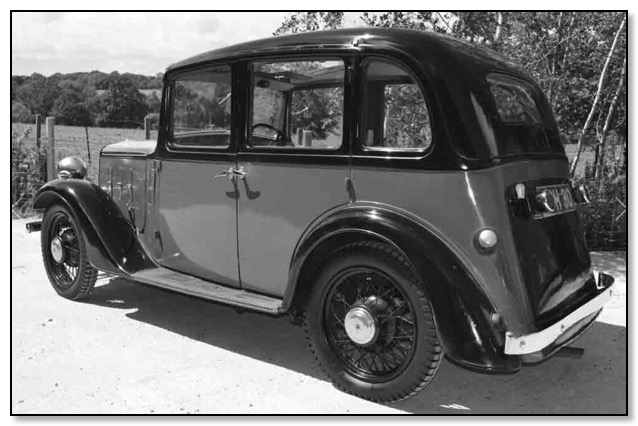
Austin Ten Four Sherborne
The Austin Ten-Four Sherborne saloon differs from previous models of its kind, because it has six side windows and a sloping down-swept back, which gives a modern appearance and enables the spare wheel and luggage carrier to be enclosed.
The body allows fair entrance all round and room for four persons. The forward doors open rearwards, which is safer even it entrance is thereby somewhat restricted. The instruments are easily seen by the driver and there is a big cupboard on the nearside. A sliding roof, a tinted glass visor, twin electric wipers which are out of the way when not in use, a mirror which gives a salt view behind, and a staves which can be opened by a handle and concealed chain to give a direct view arc fitted. The four doors have bag pockets, the floor behind is flat except for the propeller-shaft tunnel, the windows, including the quarter lights, are sensibly high, and there is enough leg and head room. The car is perhaps a little narrow in the beam in front, but the adjustable seats are well shaped and most restful. The rear cushion and squab support a passenger in the right places. The hinged sloping flush panel behind folds down to make a good-sired luggage carrier. It is a pity that it has not a false sliding platform, as other Austins, so that the spare wheel within can be lifted out without first having to disturb luggage. There arc bumpers, ventilators in the scuttle, and six ventilating doors in the sides of the bonnet. The saloon looks neat all round. The forward doors might fit closer or register into the pillars, as the water gutters drain just above.
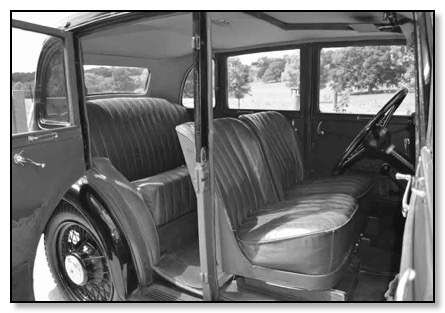
The battery and the tools are handy under the bonnet, with the radiator feller accessible on the nearside. Here are the ventilated dynamo and fan on the top of the cylinder head, the adjustor for the thermostatic control of the water circulation, and the make-and-break and distributor which face an operator and have automatic movement, the coil and light junction boxes, the water tap, the oil dip-rod and filler tube, and below the steering box, the starter. All these are get-at-able. Steering is by worm and sector with an hour-glass worm. The electrical cut-out and fuses can be quickly inspected, as they are attached to the side of the toolbox. On the nearside there are accessibly arranged the sparking plugs in the head, the carburettor, the mechanical petrol pump, and the manifolds, which are cast together and have a forward exhaust pipe. The tappets of the side valves are not too such tucked away. The all drain plug is underneath towards the rear. The single-plate dry clutch has a graphite bearing; thus there is no need of lubrication; and the four-speed centrally controlled gearbox has synchromesh for second.
The whole assembly is held at three points with rubber, the single point being central in front and the other two either side of the fly-wheel casing. The propeller-shaft is open and delivers the power to a three-quarter floating spiral bevel-driven axle. The suspension is half-elliptical and works with hydraulic shock absorbers. The front springs have some camber. The four wheel mechanical brakes are applied by cables and by pedal or central hand lever. The lever is placed where it can be got at without trouble. The frame is double dropped and cross-braced. The electrical system is 12 volt with compensating voltage control.
ON THE ROAD
The car tried had only done just over 300 miles, and therefore it is fair to make allowances. For example, any hale roughness in the running under quick acceleration or from overrun, would mostly disappear with more mileage, and I know from a trial of a previous Ten-Four that the engine, for its class, is quiet and smooth enough. It has a steady plodding nature, and a driver feels that any lack of refinement or special verve is more than made up in a car like this by trust-worthiness and simplicity. There is comfortable acceleration on all the gears, a driver has an excellent view, and the controls are handy. The catch of the hand brake lever was a little sticky. The synchromesh worked excellently, allowing straight through changes to be made silently and without delay. Nor was-it two stiff in spite of lack of use. The clutch was a shade eager when taking up a station, load on a low speed; but the standing start on third in adverse circumstances was smooth. The brakes by hand or foot were good. The suspension keeps the car well on the road, and allows one to travel comfortably. Again, after a few hundred more miles the action should improve and reduce fore ant aft motion. I liked the steering, which was light throughout the range and sufficiently steady. When fully run-in the saloon should reach 55 on the level easily and have a maximum speed of 58 to 60 miles an hour.
On the run over 50 was attained on gentle rising ground. Nearly 30 and 45 can be done on second and third. On the upgraded stretch the rates were 15 and 48, and on the new 1 in 22.5 Dashwood Hill 30 and 37. With a standing start on third at the bottom of the old hill the top was passed at 23 m.p.h. The roads were dry, there were two persons on board, and the breeze was favourable.
Specification:—No. of cyls.. 4; size. 63.5 by 89mm. capacity, 1.125c.c.: nominal h.p..9.99;b.h.p 21 at 3,000 r.p.m. : no of main bearings, 3 ; overall forward gear ratios, 5.25. 8. 12.8. and 21.1 to 1: petrol capacity 6 gals.; makers estimate of petrol consumption, 38 m.p.g. : tyres. 4.5 by 18in.: turning circle/ 37ft. 9in. : wheelbase. 7ft. 9in.: track. 9in.: ground clearance, nearly 7in.: weight of car. 17cwt.: price, £178 . A fixed saloon sells at £162 10s.
Austin Ascot Saloon (1936)
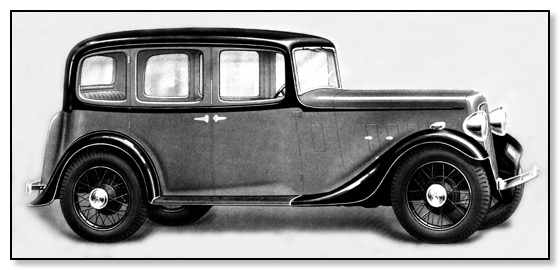
The Austin Ascot Saloon is simple and tidy in construction, line, and colour. Its aim is comfort and safety.
The four-door six-side window body is built to take four persons easily; a small fifth person can be seated at the back. The front seats are movable, entrance by the four doorways is quite good, a driver can just get to his seat from the nearside, the four window, in the doors are movable, the quarter lights are of useful size, and each door has a bag pocket. The roof, the forward part of which can be slid, allows, satisfactory head clearance, ventilators are fitted to the sides of the scuttle, the screen winds out and will just give a direct view, and a deep cupboard occupies half of the dash in front. There are tandem electric wipers. The rear floor is flat except for a small propeller-shaft tunnel, foot-rests fold flush into the backs of the front seats, three armrests are fitted for the back passenger and the forward doors are hinged in front, which is safer. The spare wheel is in a locker behind, but the luggage platform is arranged to slide sideways when the spare wheel is required.
The bonnet sides have four ventilating doors each. The screw-type of bonnet fastener is not always the easiest to work. The 6-cylinder engine has the valves on the nearside with the tappets accessible. On this side also are the downdraught carburettor, the sparking plugs in the head, the adjustable thermostat for the water circulation and the mechanical petrol pump. On the offside and also accessible are the combined ventilated dynamo and fan which can be moved for belt adjustment, the water tap, the make-and-break and distributor, which have wholly automatic movement and face an operator the oil filler tube, the starter, and the coil which is inverted on the dash. The oil filter and the drain plug can be got at only from below.
Steering is by worm and sector. The engine, single-plate clutch, and four-speed centrally controlled gearbox are assembled as a unit which is held at four points with rubber bushes. The gearbox has synchromesh for second, third, and top. Final drive is by spiral bevel in a three-quarter floating axle. The frame is cross braced the braking system is mechanical cables; rods and cables, the four brakes are applied by pedal or hand lever; and the chassis suspension is by half-elliptical springs. The front springs have some camber but are shackled forwards and the back springs are long and underhung. The springs are interleaved and have silentbloc shackles; hydraulic shock absorbers are supplied front and back..
Safety And Confidence
The engine runs honestly: it has not a high degree of refinement, but serves its purpose well, being quiet, smooth, and flexible enough. The car also has sufficient gear speeds for its type. It is simple to drive, and with the good view given, the general steadiness of the controls, and excellent suspension, imparts a feeling of confidence and safety. Since a car on the road is worth two in the ditch, so this Austin has its merits over others with more brilliant performances.
The clutch, as is usual on this make, is rather eager at times, especially with first gear. This ratio, however, need be used only for emergency. The gear lever is handy and the change speed straightforward, nor is there any need to wait with the synchromesh before engaging a fresh gear. The hand-brake lever is of good shape; being on the off side of the speed lever it is easily reached. The pedals are widely spaced so that the accelerator cannot be applied by mistake with the brake pedal. All the instruments are in front of the driver, the speedometer has a white line at the 30-mile-an-hour mark, the large horn button and the traffic signalling switch are on the top of the big-diameter ribbed steering wheel, the signallers rightly have automatic return, and the headlamp dip-and-switch is worked by a pedal. The driver has an adjustable glass visor, the large oval reflecting mirror affords a driver a proper view behind, and the screen winds out.
It will be seen that the car is sensibly arranged for convenience and safety and to allow a driver to give the greatest attention ahead. The speed lever has a catch for reverse to prevent accidental engagement, the brakes, by hand or tool, forwards or backwards - though requiring some extra physical effort for sharp deceleration-were reliable in their power, graduation, and complete evenness. The steering, though sensitive, was steady and light with an excellent lock. The suspension, as on most Austins, is better than on many cars costing twice as much. There is the least pitch and toss or up and down movement for the length of wheelbase. About 28, 45, and 65 miles an hour can be done on second, third, and top. Sixty was obtained against cross wind and a slightly rising gradient. There were two persons on board, the roads were wet, and the wind was against the car on the stretch. Here the 15 was increased to 55, the 30 at the foot of the I in 22.5. Dashwood Hill was raised to 47 at the top, and with a smooth standing start on third at the bottom of the old hill the crest was passed, with no noticeable wheel-spin on the roughened surface, at 32 miles an hour.
Specification
Number of cylinders. 6: size. 65.5mm. by 84.63mm : capacity. 1,711c.c : nominal h.p., 15.96: b.h.p. 35 at 3,000 r.p.m.: number of main bearings. 4: overall forward gear ratios,. 5.5, 8,64, 13.59, and 20.85 to I: petrol capacity. 8 gallons : makers’ estimated of petrol consumption. 24 m.p.g.: tyres. 4.75in. by 19in.: turning circle, 42ft. 2in.; wheelbase. 8ft. 10in.. track. 4ft. 2in.: ground clearance. nearly, 7.5in., weight of car, 22cwt. 3qrs., price. £235. The Ascot saloon can be supplied with 13.9 b.h.p 6-cylinder or 11.9 b.h.p 4-cylinder at a reduced price.
Austin Eighteen York Saloon (1936)
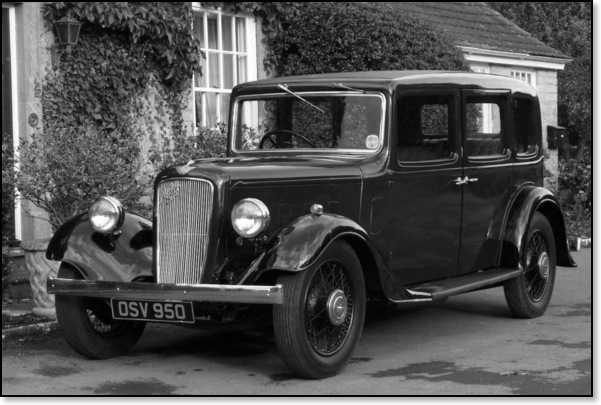
The Austin Eighteen York saloon has the family tradition of trustiness behind it, with the will to give a good all-round performance. It is roomy, comfortable, and simple to control.
Streamlining has not been attempted, but the saloon looks neat and view, headroom, and comfort have been put first. The driver gets the least obstruction to his view both in front and at the sides, while the mirror shows the road behind clearly. The back window is large, the six side windows are tall and wide, and glass wings forward of the two foremost windows allow plenty of ventilation without draught. There are louvres which can be opened in the sides of the bonnet, the fore part of the roof can be slid back, and there are ventilators in the side of the scuttle which have draught-excluding flaps for cold days. One or two points on this model which I criticized adversely in a former review, such as the inadequate opening of the windscreen and the gap which was left between the back seat and squab when the former was adjusted forwards, have been altered. The big front adjustable seats have flush-fitting tables in their backs, but these would be more useful were they fitted with raised edges.
The instruments are all in front of the driver and a large cupboard occupies the whole of the near side of the dash. The tandem wipers now work from below and are out of the driver's sight when not needed, and the motor box is placed under the bonnet. The four doors have bag pockets, and there are three blinds, a parcel net, and hydraulic jacks. There is good entrance by all four doorways. The boot door forms a luggage platform, but the sliding floor to this has been done away with, which seems a pity because it enabled the spare wheel to be lifted out without having to move luggage first, and clearance is now cut down.
The chassis has the simplicity which is characteristic of cars of this make, and the parts under the bonnet are arranged so that they can be easily got at. The bonnet side, however, should have a prop so that it will clear the water filler properly. The water circulation is governed thermostatically. The steering-box contains improved cam gear. Oil drainage cannot be done from above or at the side.
The engine, the single-plate dry clutch, and the four-speed gearbox, which has central control, a catch for reverse, and synchromesh for second, third, and top, are assembled together and mounted on rubber. The needle roller-bearing propeller shaft takes the power to a three-quarter floating spiral-bevel driven axle. The springing is half-elliptical, with self-lubricating disks between the leaves and hydraulic shock absorbers. The four-wheel Girling-type brakes are applied by pedal, or the back ones only by a central hand lever.
The engine is clearly designed for a definite purpose, That is, to give enough gear speeds and acceleration with a steady-going character such at appeals to a large number of motorists in this country. This suits the car and its class.
This saloon was quite new, and consequently due allowance must in fairness be made for a stiff engine and therefore having a little roughness which will smooth out with use, and springs which have had no chance to bed down. As a matter of fact, distinct improvement was shown in both these points after the tests on 'the way home. The driver has an excellent view all round and his position is comfortable with the controls well spaced and handy. The clutch took up its load satisfactorily. Second is the best starting gear in the normal way as first is rather low. The change speed, except for a little stiffness with the synchromesh and especially when engaging second from rest, was efficient and allowed changes with simple movements without pause. The suspension as I have said suffered from newness, but when run-in should be good, as the Austin standard of smoothness is as a rule above the average.
The car held the road well I liked the steering, the action being light throughout the range yet reliably firm. The well-set large wheel, and the horn ring switch below add to a driver's comfort and control. The brakes by hand or foot did their work properly and in either direction. The hand lever is of sensible size and accessible, being on the offside of the speed lever. It should be noted that the saloon can be had with two occasional seats making it a seven-seater at an extra charge, and also with the 15.9 h.p. engine at a lower price, while certain modifications are made for export. The machine will do nearly 55 miles in hour against breeze and gradient, and when run-in 60 to 65 should be the comfortable greatest speed on top, and the 25 and 40 on second, and third should be capable of being raised four or five miles each. On the upgraded stretch the rates were 15 and 53 those on the 1 in 21.5, Dashwood Hill were 30 and 45 and with a standing start on third the top of the old hill was passed at 30 mph. With a good start on top the engine took the saloon to within 120 yards of the crest. There was the usual load; the roads were dry; the wind was against the car.
Specification
No. of cyls. 6: size 69 x 111 mm. : capacity. 2,510 cc. : nominal hp. 17.9 : bhp. 43 at 2,600 rpm. : no. of main bearings. 4 : overall forward gear ratios: 5.11. 8.18. 12.37. and 18.86 to 1 : petrol capacity. 10 gallons : maker’s estimate of petrol consumption. 20 mpg. : tyres. 5.25 by 19in. : turning circle. 45ft. 2in. : wheelbase. 10ft. : track. 4ft. 8in. : ground clearance nearly 7.5in. : weight of car about 30cwt, : price £328 the fixed head saloon costs £118.
Austin Big Seven (1937)
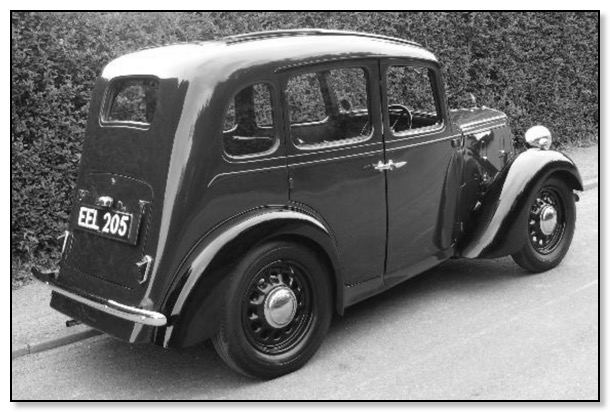
The Austin Seven has made motoring history. The Big Seven, a supplement not a substitute to it, should add lustre to the name.
It should be said at the, outset that the Big Seven, while retaining the advantages of the simple and effective general design of the Seven, differs in having a fresh and larger engine - not a bored out unit - a longer and wider chassis, and a body with four doors and six side windows. These points are sufficient to show that it is not a case of new wine into old bottles. The rear doors just allow a passenger to get in without having to move the front seats, though these are easily tipped when not in use. The back seat is slightly forward of the axle and the cushion and squab are comfortable. The upholstery is of leather and all the cushions pneumatic. The forward doors open towards the rear which is the safer plan. There are ventilators in the sides of the bonnet and of the scuttle. The elbow rests, formed by the wheel arches, should be padded. All six side windows are of good size, but if the rear cushion could have been lowered a little a rather higher view and more hat clearance would have been obtained. The forward seats give good support and are adjustable by hand. There are movable footrests under the front seats; the back floor is flat except for the tunnel over the propeller shaft. The visor for the driver is not of the most useful shape. The instruments are neatly grouped in front of the steering wheel; there is a big cupboard on the nearside. The large sloped screen is easily opened but hardly goes up far enough to allow a driver to see the road directly. There are no running boards; entrance in front is free. Luggage can be taken on the back panel door, which lets down level to form a platform. The spare wheel is kept vertically inside, which means that in order to get it out any luggage on the platform must first be moved. This Big Seven looks neat from all ways and is a good deal bigger than the Seven.
The cylinders and upper part of the crankcase are cast in one, the crankshaft is carried in three bi-metal bearings which have pressure lubrication, the pistons are of anodized low expansion aluminium alloy, and the valves are inclined. On the offside under the bonnet the battery is handy in a box on the scuttle to the front of which is attached the inverted coil - the other side of the box holds tools. The water tap, the oil filler, the dipstick, the starter, the make-and-break and distributor, the water filler, and the hour-glass worm and sector steering box are all accessible, together with the combined fan and ventilated dynamo, which are above the cylinder head. The driving belt is easily regulated. The steering box is placed more forward than on the Seven giving greater rake to the column and the track rod is forward of the axle. On the nearside are the get-at-able downdraught carburettor with a large air cleaner above, the sparking plugs, and the mechanically driven petrol pump. The tappets of the side valves can be reached without any undue difficulty.
There is a new combined induction and exhaust manifold with the exhaust pipe led away centrally. Oil drainage must be done from underneath. Engine, clutch, and gearbox are held together by a point forward at each side and one at the back of the gearbox, all with rubber. The flexible type clutch has a single spring plate carrying the two friction rings and this design helps smooth take-up. The gearbox has four speeds, with synchromesh for second. third, and top, and a centrally placed lever. The drive is taken by an open propeller shaft with needle bearing universal joints and continued by a shaft and a torque tube which is rubber mounted on the frame cross member to a three-quarter floating axle having spiral bevel gear. There arc Girling type brakes working on the wedge and roller principle.
The patented Austin Seven triangular chassis frame has wisely been adopted with suspension on the three-point plan in which a transverse half-elliptical spring is used at the front and quarter elliptical at the back. The friction shock absorbers offer a large working area. The electrical equipment is 6-volt. The fittings include foot controlled dip and switch headlamps, a petrol gauge, bumpers, and easy-clean wheels with large centres.
The car undoubtedly runs well, and although it was stiff from newness the engine gave good power. There was ready acceleration on top, while with simple changes of gear the saloon can be made very lively in pick-up and rapid manoeuvring. The unit runs reasonably quietly and proved generally smooth. The control is handy, the pedals are conveniently and safely placed, the driver has a good view forwards and backwards, and the wheel gives a restful position. The horn button and switch for the direction indicators, which have automatic return, are to hand on the top of the wheel. The steering action was light yet without back shake. The hand brake lever is on the offside of the gear lever and both are accessible. There is a catch for reverse. Changes are straightforward and the synchromesh makes them quiet. The clutch worked properly and showed considerable improvement over some of the older Austin types. The brakes by foot or hand acted sufficiently strongly with progressiveness and evenness. The car is well sprung and the extra low pressure tyres help travel to be smooth and save wheel bounce. For the wheelbase there is the least fore and aft motion. The steadiness of the drive was well shown on the roughened surface of the old Dashwood Hill, where the note of the engine hardly varied. The saloon had only done about 100 miles and therefore was tight throughout. In spite of this nearly 25 and 40 miles an hour were attained on second and third, and a mean of 55 on top. With a fully run-in car 60 should be obtainable on a good level stretch of road. The rates on the upgraded stretch were 15 and 50 and on the 1 in 22.5 mile-long hill 30 and 35. With a good standing start on third the crest of the old Dashwood Hill was passed at 27 m.p.h. The roads were dry; there were two persons on board; the breeze was across and against the car.
Specification.
Number of cyls., 4 . size. 56.77 x 88.9mm. : capacity. 900 c.c. ; nominal h.p. 7.99: b.h.p., 25 at 4 000 r.p.m. . number of main bearings, 3: overall forward gear ratios, 5.12, 8.52, 13.52, and 22.39 to I ; petrol capacity. 6 gallons; makers estimate of petrol consumption, 40 m.p.g. ; tyres. 4.75 - 16in. ; turning circle. 36ft. : wheelbase, 7ft. 3.5in. : track. just over 3ft 7in. front. 3ft. 9in. rear; ground clearance, 5.25in. weight of car, 14.5cwt. price, £160, with sliding head.
Austin Ten (1938)
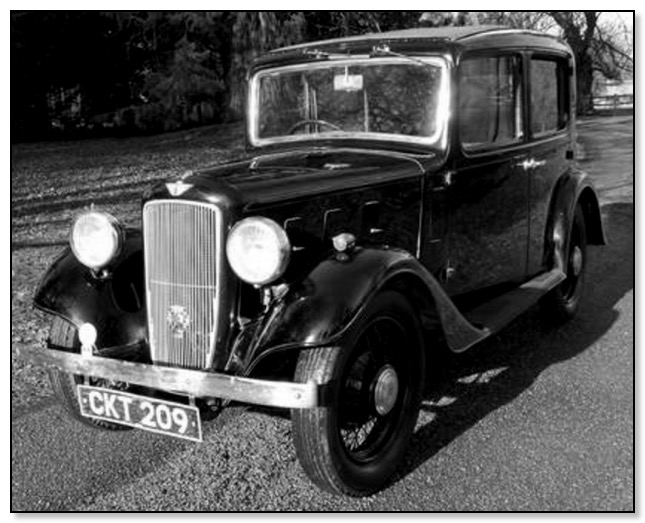
The Austin Ten saloon has been improved to combine higher efficiency with performance and greater economy. It offers even better value than before.
The body is arranged to seat four people in comfort, and the seats and squabs give adequate support. There are four doors and six side windows; good entrance is provided in front and, with the backs of the front seats tipped, entrance is free behind. The driver can see clearly both to the front and rear; passengers can enjoy the scenery. The fittings include two screen wipers, a visor for the driver, sliding roof, ventilators in the sides of the scuttle, a screen which will give a direct view, and a large divided back window. A rather tinny ash-tray of the American pattern is in front. The handbrake lever is of the pistol-grip type and, even when on, does not obstruct the driver's doorway. It is just possible to get across to the near side. The 12-volt battery is not difficult to get at, there are movable ventilators in the sides of the bonnet, and the wheels are of easy-clean type. More width is given behind in the boot. Below the luggage floor is the spare wheel. Clips are fitted to the springs for jacking. In appearance the car is somewhat upright, but comfort should be the first consideration.
On the near side, and handy, are the down-draught carburettor and air cleaner, a fume vent pipe from the side valve chamber, a mechanical petrol pump, a forward exhaust pipe, the radiator surge valve and water tap, and the sparking plugs in the new aluminium head. There are larger inlet valves than before, and the compression has been raised together with improved induction. It is possible to adjust the tappets without disturbing other parts except the cover plate. On the other side are the water filler the bonnet side does not fold back out of the way the combined ventilated dynamo and fan, the make-and-break and distributor, the oil filler tube, the dip rod, the starter, and (on the dash) the inverted coil. There is no difficulty in inspecting these parts. The worm and sector steering box is forward under the wing valance, and to reach it would be best to take off the road wheel. The flexible clutch has a spring drive and a further modification in the transmission is the three-quarter floating spiral bevel axle, which has been made stronger to cope with the increased output of the latest engine. There is also a quick-filling petrol tank. The four-speed gearbox, which has central change and synchromesh for second, third, and top, is mounted flexibly with the engine at three points. The half-elliptical springs have now double-acting piston-type hydraulic shock absorber. The brakes are of Girling wedge and roller pattern.
I liked the general control of the saloon. The engine is finer in its behaviour throughout than it was before. It is lively, will hang on to a load well for its size, and has little tendency to shake even under severe abuse. There is good power and speed for a family car of the popular type. What I particularly liked is the improved capacity for sustaining the power output throughout the lower range of piston speed. The steering was light and steady, the wheel excellently raked, the spokes do not obscure the instruments and there is a most useful lock which is, of course, a great help in manoeuvring in tight places. The clutch took up the drive, even with first from a standstill, progressively-seldom possible with previous Austin models; the gear change, the lever of which is handy and must be lifted for reverse, allows direct movements to be made quietly and without pausing in neutral. The pedals are a little close together, but the accelerator pedal is quite safe as it presses down at a different angle from that of the brake. I complained in a previous review that, although the Ten saloon held the road quite well, too much movement was felt by a back passenger, and there has been improvement here. The brakes, by hand or foot, proved efficient (except for a tendency to pull to the near side which would disappear with use and adjustment), the force being transferred properly and the pedal offering the right amount of resistance yet not being heavy in action.
On the old Dashwood Hill, with a smooth and plucky get-away on third from a standstill on the up-grade, the crest was passed at just under 25, compared with 15 m.p.h. on a previous trial, even allowing for a slightly lower third ratio. Moreover the saloon was not yet showing 500 miles use, and the roads were wet and rather sticky. There were driver and passenger. The greatest comfortable speeds I attained on second, third, and top-average--were a good 26 and over 40, without valve clatter, and 58 miles an hour. For the tests on the up-graded stretch and the 1 in 22.5 hill the slight breeze was against the car. With the respective starting rates of 15 and 30, the final speeds were 50 and a steady 35, also showing improvement on former performances.
Specification.
No. of cylinders, 4 ; size. 63.5 x 89 mm. ; capacity, 1,125 c.c : nominal b.p. 9.99 ; b.h.p.. 32 at 4,000 r.p.m. ; No. of main bearings 3 ; overall forward gear ratios. 5.37, 8.23, 13.08, and 21.6 to one : petrol capacity. 6 gallons . maker's estimate of petrol consumption. 38-40 m.p.g. : tyres. 5.25 x 16 ins. : turning circle 38ft. ; wheelbase just over 7ft. 9in. : track 3ft. 9.8in. front, nearly 3ft. 11in. rear: ground clearance just over 6ins. ; weight of car, 18.5.cwt. Price £185.
Austin Eighteen Windsor (1938)
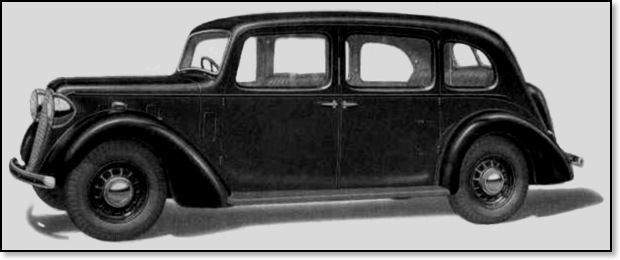
Practical economy, sterling worth, much comfort, and a more refined general performance than before characterize the Austin Eighteen Windsor seven-seater saloon.
This roomy and well proportioned car has unusually and deep side-windows. The back with its double window, the sloped boot and inset number-plate and twin sail, stop, and reverse lights set in the boot door, is shapely. In the boot there are two good-sized suitcases above the spare easy-clean wheel and tyre. Extra luggage can be taken on the platform, which lets down flat. The seating is generous and the windows give a wide view, Head clearance is most satisfactory; the front seats and the one at the back, which will take three persons, are adjustable, and give armchair support. The central pull-down armrest at the back is of double width: the rests at the sides are broad and soft. The folding occasional seats are comfortable within their limits, and there is enough knee room for a passenger here or behind. The instruments are easy to read, being in front of the driver and not obscured; a useful cupboard is on the left. The doors have large bag pockets, a parcel net is on the roof, and a wide shelf is behind the rear squab. The fittings include two handy pushes for the back inside light, two two-way visors, a sliding roof three ash-trays, twin wipers, an over-wind device for ventilation to the front windows, an opening screen, folding foot-rests, and sliding rear quarter-lights with blinds. The after floor is flat, the front one nearly.
The bonnet sides have adjustable louvres and an the dash are tool boxes and two wind horns. On the off side, the water filler is quite unobstructed, as are also the air-cooled dynamo which shares a belt drive with the combined fan and impeller, the dip stick, the make-and-break and distributor, the oil-filler tube, the coil and the cam steering box. The water tap is fairly accessible. There is a valve to save loss of water through surging; the cylinder head is now of aluminium, and allows a compression ratio of 6.5 to one with resultant greater horse power. On the nearside, and easy to reach, are the downdraught, carburettor with its economy jet and air cleaner the plugs in the head, the mechanical petrol pump, and the starter. By removing a cover plate by hand the tappets of the side valves can be got at for regulation. The manifolding is new. There is a tank on the dash for the hydraulic jacks. The flexible clutch and four-speed, centrally controlled gearbox, having, synchromesh for second, third, and top, form one assembly with the engine which is held at four points on rubber. The exhausting system is also insulated from the chassis. There is a two-piece propeller shaft, and final drive is by spiral bevel in a three-quarter floating axle. Girling wedge-and-roller brakes are fitted. The suspension is by half-elliptical springs. The engine is forward-mounted, the front springs are shackled forwards and the back ones are flat and under-slung.
The engine is much helped by the latest head towards a greater and smoother delivery of power. For its size and the type of car which is clearly built for reliable and economical use combined with comfort, there are enough acceleration and speed. The engine did its work well as did the transmission. The efficiency, of the clutch and of the carburation, was well shown with the standing starts. The gear lever is handy, with a catch for reverse, and just allows the driver to pass across to the near side. The synchromesh is perhaps a shade stiff but the car had only done some 1,700 miles; a change from third to second requires to he drawn in slowly in order to avoid scrape. The set of the controls is convenient the brakes were powerful and progressive in the delivery of force. The hand lever for the back brakes only is under the scuttle and not difficult to reach, and has a pleasing thumb release.
The steering could be a shade lighter but in the ordinary was is not hard and is firm. The car holds the road well, there is little pitch and toss, and on the climb on third the note of the engine was commendably sustained. The driver can see clearly to the front and back, but the visor in front of him might be arranged for a better angle forward. I give 30 and 50 as the greatest speeds on second and third and 65 is a comfortable rate on top. allowing a little more to be done with greater distance. The appreciable wind was across and against the car for the tests, there were two persons on board, and the road surface was damp. On the up-graded stretch the 15 was brought up to 58 and on the 1 in 22.5 hill the 30 rose to 50 miles an hour. With a standing start on third, the top of the old Dashwood Hill was cleared at a slightly accelerating 35 and a surprisingly good climb on top in view of the weight of the car, was made to within some 90 yards of the crest the engine remained smooth from start to finish, when it was pulling under heavy load down to some seven miles an hour on the 1 in 11 gradient.
Specification:- No. of cyls.. 6: size. 69.35 by 111mm. ; capacity, 2.510 c.c. ; nominal h.p., 17.9; b.h.p., 65 at 3,400 r.p.m. : number of main bearings, 4: overall forward gear ratios. 5.11. 8.18. 12.37. and 18.85 to I . petrol capacity. 13 gallons: maker's estimate of petrol consumption. 18-20 m.p,g. ; tyres, 6.5 by 16in. : turning circle 45ft. 10in. ; wheelbase, 10ft. 3in.; track. 4ft. 9in. front. 4ft. 10.5in. rear : ground clearance, 6.3in.; weight of car, 32 cwt. Price, £375.

